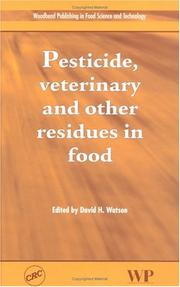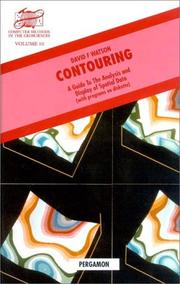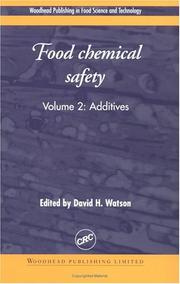| Listing 1 - 10 of 25 | << page >> |
Sort by
|
Book
ISBN: 9789289339728 9289339721 9789289339711 Year: 2015 Publisher: Nordic Council of Ministers
Abstract | Keywords | Export | Availability | Bookmark
 Loading...
Loading...Choose an application
- Reference Manager
- EndNote
- RefWorks (Direct export to RefWorks)
Book
ISBN: 9289327952 9789289327954 Year: 2014 Publisher: [Place of publication not identified] Nordic Council Of Ministers
Abstract | Keywords | Export | Availability | Bookmark
 Loading...
Loading...Choose an application
- Reference Manager
- EndNote
- RefWorks (Direct export to RefWorks)
This report is the primary outcome from Part I of the project "Towards a Nordic textile strategy - Collection, sorting, reuse and recycling of textiles" initiated by the Nordic Waste Group (NAG). The report for Part 2 will be published in December 2014. This report summarizes the work carried out in 2013. The three subreports will be the basis for the work to be performed in 2014. The reports for 2013 are: International market survey of textile flows in the Nordic region and the market for collection, sorting, preparing for reuse, reselling and waste management of textiles. Collection and sorting systems. A total of 19 collection systems are compared for collection flows, contamination levels, cost, suitability of collected textile and availability for the consumer. Four sorting systems are described. Technology review of sorting and recycling of textiles that describes available and future technology. The report is part of the Nordic Prime Ministers' overall green growth initiative: "The Nordic Region - leading in green growth." Read more in the web magazine "Green Growth the Nordic Way" at www.norden.org/greengrowth.
Textile fabrics. --- Cloth --- Fabrics --- Textile industry and fabrics --- Textiles --- Decorative arts --- Dry-goods --- Weaving --- Textile fibers
Multi
ISBN: 9780857093035 0857093037 9781855732742 Year: 1992 Publisher: West Sussex, England : Ellis Horwood,
Abstract | Keywords | Export | Availability | Bookmark
 Loading...
Loading...Choose an application
- Reference Manager
- EndNote
- RefWorks (Direct export to RefWorks)
Bridging the gap between journal articles and specialised books, Food Science Reviews provides expert coverage of key areas of food science. Drawing solely on contributions from leading scientists, the collated essays established themselves as a standard reference on the most interesting current work in the field. This topical first volume covers an area which is increasingly in the public and scientific eye. Expert contributions on all aspects of the microbiological and chemical safety of food provide a key review of food hygiene and safety.
Food handling. --- Food adulteration and inspection. --- Food --- Microbiology.

ISBN: 9780080429991 0080429998 9780080913421 0080913423 Year: 1998 Volume: v. 1 Publisher: [Place of publication not identified] Elsevier
Abstract | Keywords | Export | Availability | Bookmark
 Loading...
Loading...Choose an application
- Reference Manager
- EndNote
- RefWorks (Direct export to RefWorks)
The ever-growing demand for commercial activities at sea has meant that ships are rapidly developing and that the rules governing their construction and operation are changing. Practical Ship Design records these changes, their outcomes and the reasoning behind them. It deals with every aspect of ship design and handles a wide range of both merchant ships and naval ships with authority. It provides coverage of cargo ships and passenger ships, tugs, dredgers and other service craft. It also includes concept design, detail design, structural design, hydrodynamics design, the effect of regulations, the preparation of specifications and matters of costs and economics. Drawing on the author's extensive practical experience, Practical Ship Design is likely to interest everybody involved in the design, construction, repair and operation of ships. Students and the most experienced professionals will all benefit from the book's vast store of design data and its conclusions and recommendations.
Naval architecture. --- Architecture navale --- Naval architecture --- Military & Naval Science --- Naval Architecture --- Law, Politics & Government --- Architecture, Naval --- Marine architecture --- Ships --- Architecture --- Shipbuilding --- Design and construction --- Nautical influences

ISBN: 1855737345 0849325587 9786610361588 1855739100 1280361581 1591249260 9781855737341 9781280361586 9781855739109 9780849325588 9781591249269 Year: 1977 Publisher: Cleveland Cambridge CRC Press Woodhead publishing limited
Abstract | Keywords | Export | Availability | Bookmark
 Loading...
Loading...Choose an application
- Reference Manager
- EndNote
- RefWorks (Direct export to RefWorks)
This wide-ranging text reviews the wealth of recent research on assessing and managing the risks from pesticide, veterinary and other chemical residues in food. After an introductory chapter on the key issues in food toxicology,Part one covers the assessment and management of risks, with individual chapters on genetic susceptibility to dietary carcinogens, good agricultural practice and HACCP systems, targeted and rapid methods for analysing residues in food and ways of assessing the mutagenicity of chemicals in food. Part two looks at veterinary residues, covering their safety, toxico
Feed additive residues --- Food contamination --- Food --- Nutritionally induced diseases --- Pesticide residues in food --- Veterinary drug residues --- Pesticide residues --- Pesticides --- Diet --- Diet and disease --- Dietary causes of disease --- Diseases --- Nutrition disorders --- Food toxicology --- Nutritional toxicology --- Toxicology --- Contaminated food --- Foods, Contaminated --- Contamination (Technology) --- Food adulteration and inspection --- Residues, Veterinary drug --- Residues, Feed additive --- Environmental aspects --- Adverse effects --- Dietary aspects --- Causes and theories of causation --- Contamination --- Engineering --- Food Science and Technology --- Food contamination. --- Toxicology. --- Drug residues --- Veterinary drug residues. --- Analysis.

ISBN: 0080402860 9780080402864 9781483287355 1483287351 Year: 1992 Publisher: Oxford, England : Pergamon Press Ltd,
Abstract | Keywords | Export | Availability | Bookmark
 Loading...
Loading...Choose an application
- Reference Manager
- EndNote
- RefWorks (Direct export to RefWorks)
This unique book is the key to computer contouring, exploring in detail the practice and principles using a personal computer. Contouring allows a three dimensional view in two dimensions and is a fundamental technique to represent spatial data. All aspects of this type of representation are covered including data preparation, selecting contour intervals, interpolation and griding, computing volumes and output and display. Formulated for both the novice and the experienced user, this book initially conducts the reader through a step by step explanation of PC software and its application to per
Contours (Cartography) --- Computer programs. --- -Contour lines (Cartography) --- Isohypse --- Map contours --- Altitudes --- Computer programs --- Contour lines (Cartography) --- Cartography --- Topographic maps --- Contours (Cartography) - Computer programs
Book
ISBN: 3030171523 3030171515 Year: 2019 Publisher: Cham : Springer International Publishing : Imprint: Springer,
Abstract | Keywords | Export | Availability | Bookmark
 Loading...
Loading...Choose an application
- Reference Manager
- EndNote
- RefWorks (Direct export to RefWorks)
This book explores a wide range of topics in digital ethics. It features 11 chapters that analyze the opportunities and the ethical challenges posed by digital innovation, delineate new approaches to solve them, and offer concrete guidance to harness the potential for good of digital technologies. The contributors are all members of the Digital Ethics Lab (the DELab), a research environment that draws on a wide range of academic traditions. The chapters highlight the inherently multidisciplinary nature of the subject, which cannot be separated from the epistemological foundations of the technologies themselves or the political implications of the requisite reforms. Coverage illustrates the importance of expert knowledge in the project of designing new reforms and political systems for the digital age. The contributions also show how this task requires a deep self-understanding of who we are as individuals and as a species. The questions raised here have ancient -- perhaps even timeless -- roots. The phenomena they address may be new. But, the contributors examine the fundamental concepts that undergird them: good and evil, justice and truth. Indeed, every epoch has its great challenges. The role of philosophy must be to redefine the meaning of these concepts in light of the particular challenges it faces. This is true also for the digital age. This book takes an important step towards redefining and re-implementing fundamental ethical concepts to this new era.
Technology --- Moral and ethical aspects. --- Technology and ethics --- Philosophy. --- Technology—Sociological aspects. --- Computer security. --- Ethics. --- Computer crimes. --- Philosophy of Technology. --- Science and Technology Studies. --- Privacy. --- Cybercrime. --- Computers and crime --- Cyber crimes --- Cybercrimes --- Electronic crimes (Computer crimes) --- Internet crimes --- Crime --- Privacy, Right of --- Deontology --- Ethics, Primitive --- Ethology --- Moral philosophy --- Morality --- Morals --- Philosophy, Moral --- Science, Moral --- Philosophy --- Values --- Computer privacy --- Computer system security --- Computer systems --- Computers --- Cyber security --- Cybersecurity --- Electronic digital computers --- Protection of computer systems --- Security of computer systems --- Data protection --- Security systems --- Hacking --- Mental philosophy --- Humanities --- Protection --- Security measures
Book
ISBN: 303087074X 3030870731 9783030870744 Year: 2021 Publisher: Cham : Springer International Publishing : Imprint: Palgrave Macmillan,
Abstract | Keywords | Export | Availability | Bookmark
 Loading...
Loading...Choose an application
- Reference Manager
- EndNote
- RefWorks (Direct export to RefWorks)
Truth to Post-Truth in American Detective Fiction examines questions of truth and relativism, turning to detectives, both real and imagined, from Poe’s C. Auguste Dupin to Robert Mueller, to establish an oblique history of the path from a world where not believing in truth was unthinkable to the present, where it is common to believe that objective truth is a remnant of a simpler, more naïve time. Examining detective stories both literary and popular including hard-boiled, postmodern, and twenty-first century novels, the book establishes that examining detective fiction allows for a unique view of this progression to post-truth since the detective’s ultimate job is to take the reader from doubt to belief. David Riddle Watson shows that objectivity is intersubjectivity, arguing that the belief in multiple worlds is ultimately what sustains the illusion of relativism.
Detective and mystery stories, American --- Truth in literature. --- History and criticism. --- Literature, Modern --- America --- Language and languages --- Rhetoric. --- Metaphysics. --- Mass media and crime. --- Ethnology --- Culture. --- Contemporary Literature. --- North American Literature. --- Rhetorics. --- Crime and the Media. --- American Culture. --- Cultural sociology --- Culture --- Sociology of culture --- Civilization --- Popular culture --- Crime and mass media --- Crime --- Philosophy --- God --- Ontology --- Philosophy of mind --- Speaking --- Authorship --- Expression --- Literary style --- Linguostylistics --- Stylistics --- Literature --- 20th century. --- 21st century. --- Literatures. --- Style. --- America. --- Social aspects --- Rhetoric

ISBN: 1855734621 1855735636 9781855736320 1855736322 9781855734623 9781855736337 1855736330 9781855735637 9786610372256 1591243432 1280372257 9786610372584 1591243475 1280372583 0849312116 0849312108 9780849312106 9780849312113 Year: 2001 Publisher: Cambridge, England ; Boca Raton, Florida : Woodhead Publishing Limited : CRC Press,
Abstract | Keywords | Export | Availability | Bookmark
 Loading...
Loading...Choose an application
- Reference Manager
- EndNote
- RefWorks (Direct export to RefWorks)
Chemical contaminants in food, from pesticides and veterinary drug residues to contamination from food packaging, are a major concern for the food industry. Written by a distinguished international team of contributors, this authoritative collection describes the main chemical contaminants, their health implications, how they contaminate food products, methods of detection and how such contaminants can be controlled.Describes the main chemical contaminants of food, their health implications, how they contaminate food products, methods of detection and how such contaminants can
Nutritionary hygiene. Diet --- Toxicology --- Agrotechnology and Food Sciences. Food Sciences --- Food Chemistry --- Additives and Contaminants. --- Engineering --- Food Science and Technology --- Food contamination. --- Pollution. --- Public Health --- Public Health. --- Health & Biological Sciences --- Diet & Clinical Nutrition --- Food adulteration and inspection --- Food --- Analysis of food --- Food, Pure --- Food inspection --- Inspection of food --- Pure food --- Adulterations --- Consumer protection --- Public health --- Sanitary chemistry --- Contaminated food --- Foods, Contaminated --- Contamination (Technology) --- Chemistry of food --- Food, Chemistry of --- Food chemistry --- Chemistry, Technical --- Standards. --- Analysis. --- Adulteration --- Inspection --- Contamination --- Chemistry --- Composition --- Mycotoxins --- Pesticides --- Risk assessment --- Safety --- Veterinary drugs --- FOOD ADDITIVES --- FOOD ANALYSIS --- SAFETY --- PUBLIC HEALTH --- RISK ASSESSMENT --- ANALYSIS --- STANDARDS
Multi
ISBN: 1299833144 9781299833142 9781597497459 1597497452 9781597497428 1597497428 Year: 2013 Publisher: Boston Syngress
Abstract | Keywords | Export | Availability | Bookmark
 Loading...
Loading...Choose an application
- Reference Manager
- EndNote
- RefWorks (Direct export to RefWorks)
This is the first digital forensics book that covers the complete life cycle of digital evidence and the chain of custody. This comprehensive handbook includes international procedures, best practices, compliance, and a companion web site with downloadable forms. Written by world-renowned digital forensics experts, this book is a must for any digital forensics lab. It provides anyone who handles digital evidence with a guide to proper procedure throughout the chain of custody--from incident response through analysis in the lab. A step-by-step guide to designing, building a
Computer crimes --- Evidence preservation --- Forensic sciences --- Computer science. --- Investigation. --- Standards.
| Listing 1 - 10 of 25 | << page >> |
Sort by
|

 Search
Search Feedback
Feedback About UniCat
About UniCat  Help
Help News
News